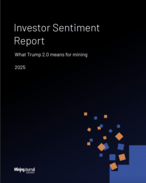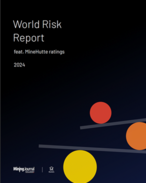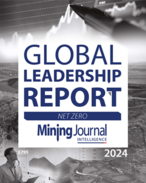BHP claims that last year's failed bid for Anglo American was not an attempt to plug a short-term earnings hole but Goldman Sachs, a leading investment bank, reckons the hole is real, opening the way for Rio Tinto to outperform its great rival over the next five years.
The never-ending two-company drag race which pits the world's leading diversified miners against each other routinely sees a flip between BHP and Rio being the better buy for investors.
Goldman Sachs, in a research note circulated last week, hedges its bets when it comes to a recommendation, telling clients to buy both which is surprising as the bank mounts a convincing case for Rio Tinto outperforming BHP until at least 2030.
Anglo American does not feature in the 36-page report which closely compares Rio Tinto with BHP, either an oversight or Goldman Sachs being unusually polite in ignoring the blunt rejection BHP received from Anglo American management and South African politicians.
Not mentioning one of BHP's bigger blunders of walking into a lion's den unprepared for a hostile reception is made more obvious by the bank's assessment of critical measures such a production growth and free cash flow which sees BHP come a distant second.
Without ownership of Anglo American's crown jewels, its high-quality copper assets, Goldman Sachs sees five flat years for BHP's annual copper equivalent mineral production, whereas Rio Tinto's copper equivalent output will grow at between 3%-and-4% a year between now and 2030.
"We expect Rio Tinto to widen the production and free cash flow gap over BHP over the next five years," the bank said. "This is a key reason we prefer Rio Tinto over BHP."
Analysis
The analysis of the two big miners starts with a "deep dive" into their project pipelines with Goldman Sachs noting that both companies have entered a period of heavy investment with capital expenditure set to reach a 10-year high, affecting their free cash flow.
Both BHP and Rio Tinto have project investment pipelines costing US$50-and-$60 billion, excluding routine maintenance.
"Despite both companies spending around $10-to-$11 billion a year we expect Rio Tinto to widen the copper equivalent production and free cash flow gap over BHP during the next five years," Goldman Sachs said.
"Cumulatively, we expect Rio Tinto's copper equivalent production to grow by around 20% by the end of the decade versus BHP with almost no growth."
Rio growth
The bank said Rio Tinto focused on growth around five years ago (Simandou and Pilbara iron ore, Oyu Tolgoi copper, and Rincon/Arcadium lithium) whereas BHP's growth is longer dated mostly because the company decision to defer project studies into Chilean copper and the expansion of the Olympic Dam copper smelter in South Australia.
"As a result, our Rio Tinto earnings before interest tax and other charges (Ebitda) is increasing by 30% over 2025-to-2030 (around 5% a year) versus BHP's increase at just 6%," Goldman Sachs said.
"In fact, we forecast Rio Tinto's Ebitda to exceed BHP's by US$4 billion, or 15%, by 2030."
It's forecast like that which highlight last year's urgency in trying to acquire Anglo American which would have delivered growth earnings growth while masking the fact that BHP's existing assets had effectively gone ex-growth (no growth).
Share price moves over the last six months show that investors have recognised the widening gap between Rio Tinto and BHP with Rio Tinto's shares on the Australian stock exchange up 8% v BHP which is essentially steady, or down fractionally.
Cash flows
The stronger free cash flows which Rio Tinto is starting to enjoy are expected by Goldman Sachs to soon be felt in shareholder returns.
The bank said that a look at capital management showed that Rio Tinto could maintain a 60% dividend payout, while trading on a dividend yield of 6% to 8% over the medium term.
BHP, on the other hand is forecast to offer a 4% dividend yield on a 50% net profit payout ratio over the same period.
Because both companies have broadly similar iron ore operations the comparison is largely focused on copper, which is where Rio Tinto has a clear advantage for the next five years especially as BHP's copper output is expected to decline from two million tonnes this year to 1.6m/t in 2028.
"We believe BHP should look to accelerate the Laguna Seca debottlenecking project which could help offset half of the expected production decline from 2028-to-2030," the bank said.
Missing from the Goldman Sachs analysis is the Anglo American elephant in the room because if BHP had stalked its prey with greater skill, and had better understanding of South African politics, it might not now be facing five years of playing second fiddle to Rio Tinto.






















MINER'S RIGHT
BHP's Anglo miss sees playing second fiddle to Rio Tinto
Analysis of the two big miners
Miner's Right | Credits: Aspermont
BHP claims that last year's failed bid for Anglo American was not an attempt to plug a short-term earnings hole but Goldman Sachs, a leading investment bank, reckons the hole is real, opening the way for Rio Tinto to outperform its great rival over the next five years.
The never-ending two-company drag race which pits the world's leading diversified miners against each other routinely sees a flip between BHP and Rio being the better buy for investors.
Goldman Sachs, in a research note circulated last week, hedges its bets when it comes to a recommendation, telling clients to buy both which is surprising as the bank mounts a convincing case for Rio Tinto outperforming BHP until at least 2030.
Anglo American does not feature in the 36-page report which closely compares Rio Tinto with BHP, either an oversight or Goldman Sachs being unusually polite in ignoring the blunt rejection BHP received from Anglo American management and South African politicians.
YOU MIGHT ALSO LIKE
Not mentioning one of BHP's bigger blunders of walking into a lion's den unprepared for a hostile reception is made more obvious by the bank's assessment of critical measures such a production growth and free cash flow which sees BHP come a distant second.
Without ownership of Anglo American's crown jewels, its high-quality copper assets, Goldman Sachs sees five flat years for BHP's annual copper equivalent mineral production, whereas Rio Tinto's copper equivalent output will grow at between 3%-and-4% a year between now and 2030.
"We expect Rio Tinto to widen the production and free cash flow gap over BHP over the next five years," the bank said. "This is a key reason we prefer Rio Tinto over BHP."
Analysis
The analysis of the two big miners starts with a "deep dive" into their project pipelines with Goldman Sachs noting that both companies have entered a period of heavy investment with capital expenditure set to reach a 10-year high, affecting their free cash flow.
Both BHP and Rio Tinto have project investment pipelines costing US$50-and-$60 billion, excluding routine maintenance.
"Despite both companies spending around $10-to-$11 billion a year we expect Rio Tinto to widen the copper equivalent production and free cash flow gap over BHP during the next five years," Goldman Sachs said.
"Cumulatively, we expect Rio Tinto's copper equivalent production to grow by around 20% by the end of the decade versus BHP with almost no growth."
Rio growth
The bank said Rio Tinto focused on growth around five years ago (Simandou and Pilbara iron ore, Oyu Tolgoi copper, and Rincon/Arcadium lithium) whereas BHP's growth is longer dated mostly because the company decision to defer project studies into Chilean copper and the expansion of the Olympic Dam copper smelter in South Australia.
"As a result, our Rio Tinto earnings before interest tax and other charges (Ebitda) is increasing by 30% over 2025-to-2030 (around 5% a year) versus BHP's increase at just 6%," Goldman Sachs said.
"In fact, we forecast Rio Tinto's Ebitda to exceed BHP's by US$4 billion, or 15%, by 2030."
It's forecast like that which highlight last year's urgency in trying to acquire Anglo American which would have delivered growth earnings growth while masking the fact that BHP's existing assets had effectively gone ex-growth (no growth).
Share price moves over the last six months show that investors have recognised the widening gap between Rio Tinto and BHP with Rio Tinto's shares on the Australian stock exchange up 8% v BHP which is essentially steady, or down fractionally.
Cash flows
The stronger free cash flows which Rio Tinto is starting to enjoy are expected by Goldman Sachs to soon be felt in shareholder returns.
The bank said that a look at capital management showed that Rio Tinto could maintain a 60% dividend payout, while trading on a dividend yield of 6% to 8% over the medium term.
BHP, on the other hand is forecast to offer a 4% dividend yield on a 50% net profit payout ratio over the same period.
Because both companies have broadly similar iron ore operations the comparison is largely focused on copper, which is where Rio Tinto has a clear advantage for the next five years especially as BHP's copper output is expected to decline from two million tonnes this year to 1.6m/t in 2028.
"We believe BHP should look to accelerate the Laguna Seca debottlenecking project which could help offset half of the expected production decline from 2028-to-2030," the bank said.
Missing from the Goldman Sachs analysis is the Anglo American elephant in the room because if BHP had stalked its prey with greater skill, and had better understanding of South African politics, it might not now be facing five years of playing second fiddle to Rio Tinto.
RELATED ARTICLES
THEMES:
TOPICS:
< PREVIOUS ARTICLE
BHP tries again in Africa
NEXT ARTICLE >
Simandou sneak preview before Rio's annual meeting next week
Get the Mining Journal Newsletter delivered free each day
FROM OUR PARTNERS
PARTNER CONTENT
Macquarie Arc: Elephants hiding in plain sight
PARTNER CONTENT
BHP builds 'beautiful' Xplor community